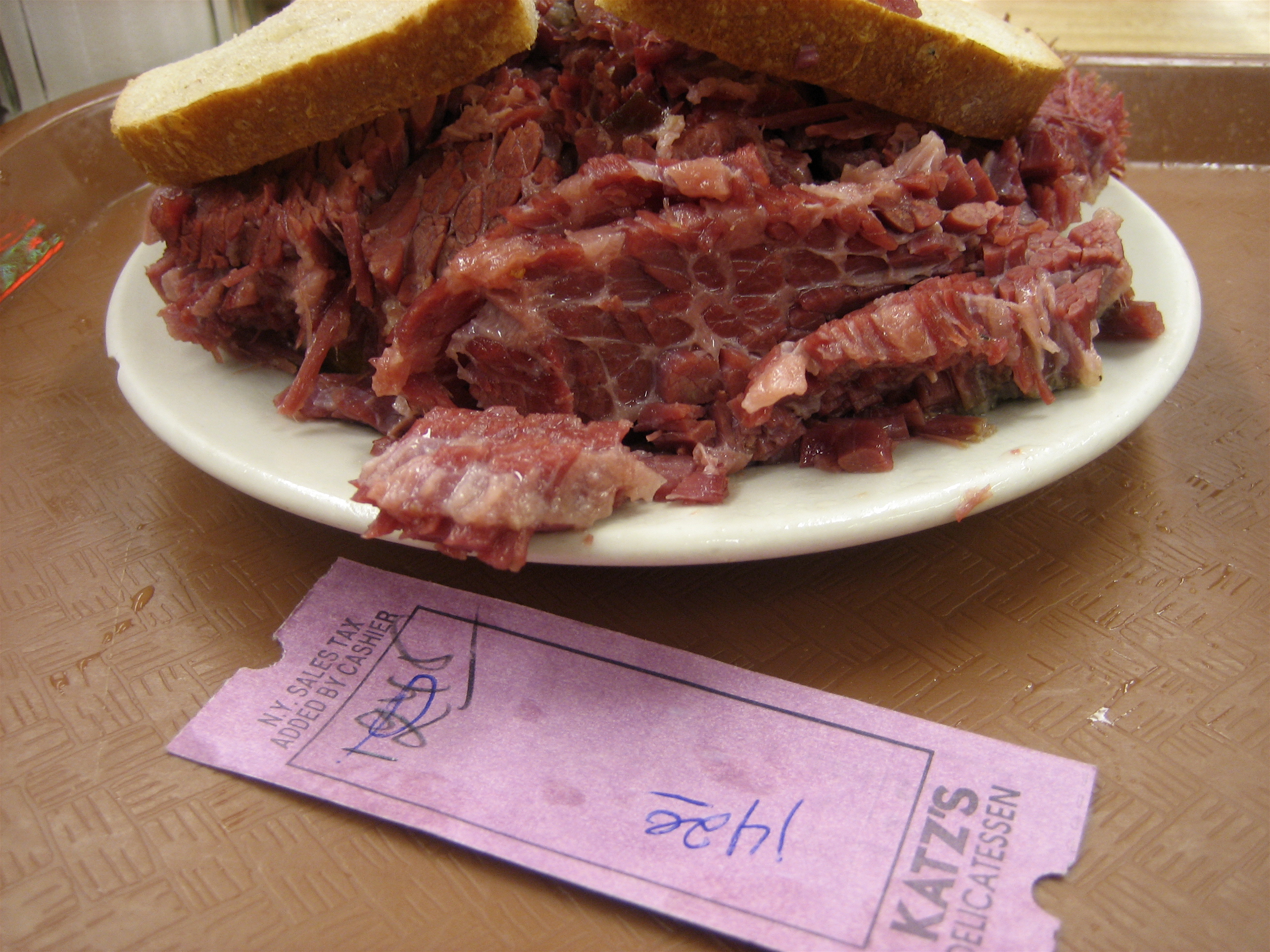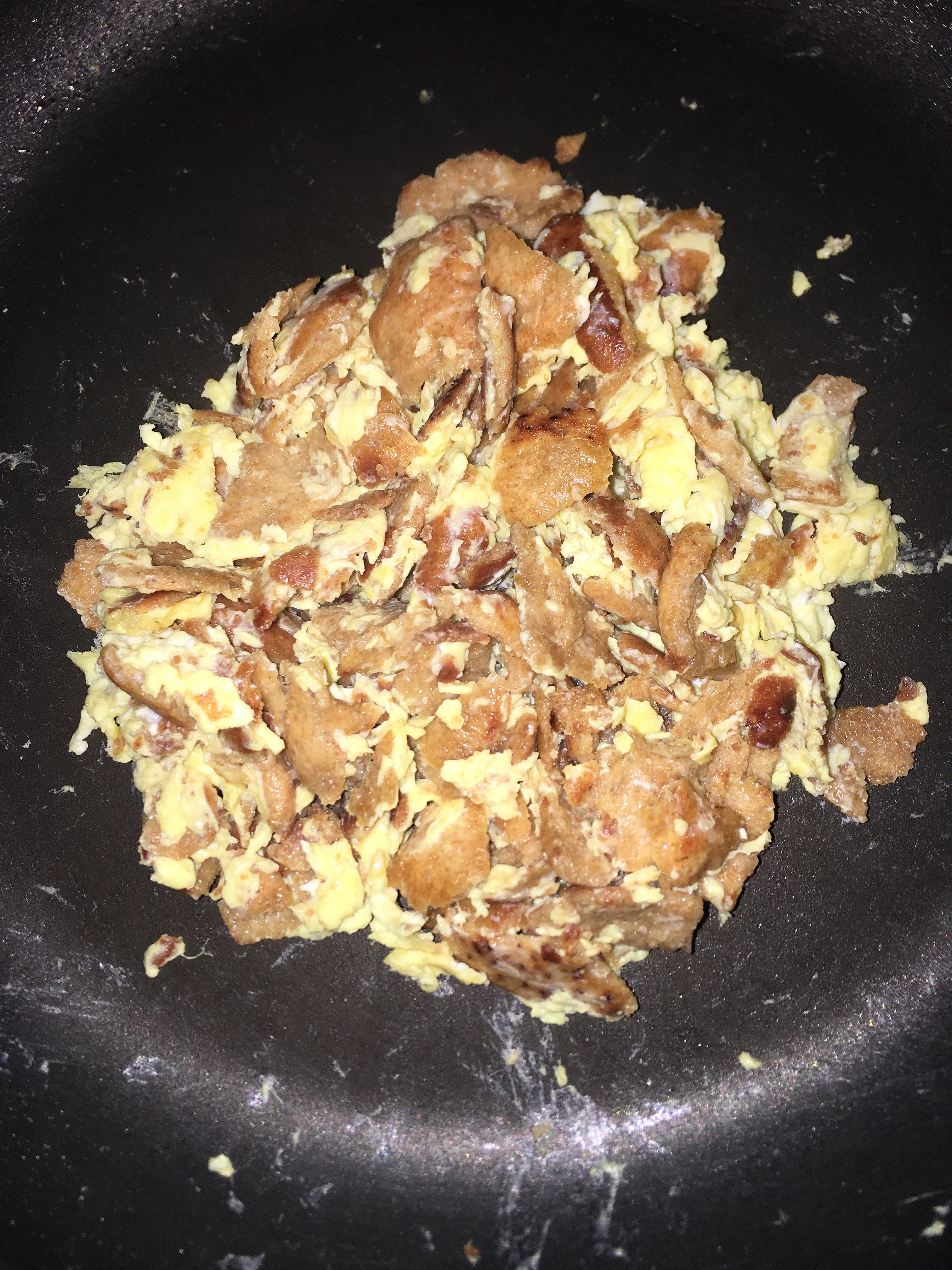|
Matzoquiles
Matzoquiles is a Mexican–Jewish fusion dish somewhat similar to the Ashkenazi Jewish dish matzah brei, the Mexican dish chilaquiles, and the Yemenite Jewish dish fatoot samneh, and is popular during Passover. Overview Matzoquiles are often a homemade dish served during Passover. Some restaurants serve matzoquiles such as Wise Sons in San Francisco, which serves their version with a tomatillo-pasilla chile salsa Verde. Preparation Typically, sheets of matzo are broken into large pieces and lightly fried. Sometime pieces of matzo are broken and soaked in beaten eggs, which are then scrambled together similar to a matzah brei. Red or green salsa is poured over the crisp matzo pieces. The mixture is simmered until the matzo pieces begin to soften. Matzoquiles are commonly garnished with sour cream, cheese, sliced onion, avocado, and radish slices. Matzoquiles are often served with guacamole, or refried beans, and topped with eggs scrambled or fried. References See also * ... [...More Info...] [...Related Items...] OR: [Wikipedia] [Google] [Baidu] |
Matzah Brei
Matzah brei ( yi, מצה ברײַ ''matse bray'', literally 'matzah porridge'; he, מצה בריי, ''matzah brei'', or , ''matzah metugenet'', literally, "fried matzah"), sometimes spelled matzah brie, matzoh brei, or matzo brei, is a dish of Ashkenazi Jewish origin made from matzah fried with eggs. It is commonly eaten as a breakfast food during the Jewish holiday of Passover. Etymology The Yiddish term מצה ברײַ ''matse bray'' literally means 'matzah porridge'; ברײַ ''bray'' 'porridge' is descended from a Middle High German word ''brī'' of the same meaning. History Gil Marks in his ''Encyclopedia of Jewish Food'' asserts that matzah brei as a fried matzah-and-egg dish originated in North America. He notes the publication of a recipe for "Fried Matzos", consisting of soaked whole matzah fried in butter or schmaltz, in ''The Jewish Manual'' (London, 1846). However, egg-based recipes began to be published in early Jewish-American cookbooks, including ''Aunt Babette ... [...More Info...] [...Related Items...] OR: [Wikipedia] [Google] [Baidu] |
American Jewish Cuisine
American Jewish cuisine comprises the food, cooking, and dining customs associated with American Jews. It was heavily influenced by the cuisine of Jewish immigrants who came to the United States from Eastern Europe around the turn of the 20th century. It was further developed in unique ways by the immigrants and their descendants, especially in New York City and other large metropolitan areas of the northeastern U.S. History Between 1881 and 1921, around 2.5 million Jews immigrated to the United States from Eastern Europe. Most of them settled in large cities in the northeastern part of the country, especially New York, Philadelphia, Boston, Cleveland, Chicago, and Baltimore. These immigrants brought with them a well-developed culinary heritage. The cuisine continued to evolve in America, in the homes of the immigrants and their descendants, and in delicatessens and appetizing stores in New York City and elsewhere. Delicatessens were quite popular among second-generation Ameri ... [...More Info...] [...Related Items...] OR: [Wikipedia] [Google] [Baidu] |
Fatoot Samneh
Fatoot samneh ( he, פטאוט סמנה) is a dish originating in Yemeni cuisine, consisting of pieces of ''saluf'' or ''malawach'' (Yemeni flatbreads), or pita, that have been fried in clarified butter and combined with beaten egg. It is commonly served as a breakfast or dinner dish. It was brought to Israel by Yemenite Jews. It is somewhat similar to the Jewish cuisine, Jewish matzah brei or the Mexican American cuisine, Mexican-American migas, which are made with Matzah, matzo, and corn tortillas, respectively; whereas fatoot samneh is made with pita bread. Origins Fatoot samneh originated as a way for the Yemenite Jewish community to use and repurpose stale pita bread that would have otherwise been discarded. The Yemenite Jewish community was historically very poor, and most of their meals consisted of various soups and stews. Bread such as pita was very valuable, as was ''"samneh"'', or clarified butter, and their families were often large and the women of the community tra ... [...More Info...] [...Related Items...] OR: [Wikipedia] [Google] [Baidu] |
Mexican Cuisine
Mexican cuisine consists of the cooking cuisines and traditions of the modern country of Mexico. Its earliest roots lie in Mesoamerican cuisine. Its ingredients and methods begin with the first agricultural communities such as the Olmec and Maya who domesticated maize, created the standard process of maize nixtamalization, and established their foodways. Successive waves of other Mesoamerican groups brought with them their own cooking methods. These included: the Teotihuacanos, Toltec, Huastec, Zapotec, Mixtec, Otomi, Purépecha, Totonac, Mazatec, Mazahua, and Nahua. With the Mexica formation of the multi-ethnic Triple Alliance ( Aztec Empire), culinary foodways became infused (Aztec cuisine). Today's food staples native to the land include corn (maize), turkey, beans, squash, amaranth, chia, avocados, tomatoes, tomatillos, cacao, vanilla, agave, spirulina, sweet potato, cactus, and chili pepper. Its history over the centuries has resulted in regional cuisine ... [...More Info...] [...Related Items...] OR: [Wikipedia] [Google] [Baidu] |
Mexican-American Culture
Mexican Americans ( es, mexicano-estadounidenses, , or ) are Americans of full or partial Mexican heritage. In 2019, Mexican Americans comprised 11.3% of the US population and 61.5% of all Hispanic and Latino Americans. In 2019, 71% of Mexican Americans were born in the United States, though they make up 53% of the total population of foreign-born Latino Americans and 25% of the total foreign-born population. The United States is home to the second-largest Mexican community in the world (24% of the entire Mexican-origin population of the world), behind only Mexico. Most Mexican Americans reside in the Southwest (over 60% in the states of California and Texas). Many Mexican Americans living in the United States have assimilated into American culture which has made some become less connected with their culture of birth (or of their parents/ grandparents) and sometimes creates an identity crisis. Most Mexican Americans have varying degrees of Indigenous and European ances ... [...More Info...] [...Related Items...] OR: [Wikipedia] [Google] [Baidu] |
Jews And Judaism In Mexico
Jews ( he, יְהוּדִים, , ) or Jewish people are an ethnoreligious group and nation originating from the Israelites Israelite origins and kingdom: "The first act in the long drama of Jewish history is the age of the Israelites""The people of the Kingdom of Israel and the ethnic and religious group known as the Jewish people that descended from them have been subjected to a number of forced migrations in their history" and Hebrews of historical History of ancient Israel and Judah, Israel and Judah. Jewish ethnicity, nationhood, and religion are strongly interrelated, "Historically, the religious and ethnic dimensions of Jewish identity have been closely interwoven. In fact, so closely bound are they, that the traditional Jewish lexicon hardly distinguishes between the two concepts. Jewish religious practice, by definition, was observed exclusively by the Jewish people, and notions of Jewish peoplehood, nation, and community were suffused with faith in the Jewish God, ... [...More Info...] [...Related Items...] OR: [Wikipedia] [Google] [Baidu] |
Jewish Cuisine
Jewish cuisine refers to the worldwide cooking traditions of the Jewish people. During its evolution over the course of many centuries, it has been shaped by Jewish dietary laws (''kashrut''), Jewish festivals and holidays, and traditions centred around Shabbat. Jewish cuisine is influenced by the economics, agriculture, and culinary traditions of the many countries where Jewish communities have settled and varies widely throughout the entire world. The history of Jewish cuisine begins with the cuisine of the ancient Israelites. As the Jewish diaspora grew, different styles of Jewish cooking developed. The distinctive styles in Jewish cuisine vary by each community across the Ashkenazi, Sephardi, and Mizrahi diaspora groupings; there are also notable dishes within the culinary traditions of the stand-alone significant Jewish diaspora communities from Greece, Iran, and Yemen. Since the establishment of the State of Israel in 1948, and particularly since the late 1970s, ... [...More Info...] [...Related Items...] OR: [Wikipedia] [Google] [Baidu] |
Jewish American Cuisine
American Jewish cuisine comprises the food, cooking, and dining customs associated with American Jews. It was heavily influenced by the cuisine of Jewish immigrants who came to the United States from Eastern Europe around the turn of the 20th century. It was further developed in unique ways by the immigrants and their descendants, especially in New York City and other large metropolitan areas of the northeastern U.S. History Between 1881 and 1921, around 2.5 million Jews immigrated to the United States from Eastern Europe. Most of them settled in large cities in the northeastern part of the country, especially New York, Philadelphia, Boston, Cleveland, Chicago, and Baltimore. These immigrants brought with them a well-developed culinary heritage. The cuisine continued to evolve in America, in the homes of the immigrants and their descendants, and in delicatessens and appetizing stores in New York City and elsewhere. Delicatessens were quite popular among second-generation Amer ... [...More Info...] [...Related Items...] OR: [Wikipedia] [Google] [Baidu] |
Hispanic And Latino-Jewish Culture In The United States
The term ''Hispanic'' ( es, hispano) refers to people, cultures, or countries related to Spain, the Spanish language, or Hispanidad. The term commonly applies to countries with a cultural and historical link to Spain and to viceroyalties formerly part of the Spanish Empire following the Spanish colonization of the Americas, parts of the Asia-Pacific region and Africa. Outside of Spain, the Spanish language is a predominant or official language in the countries of Hispanic America and Equatorial Guinea. Further, the cultures of these countries were influenced by Spain to different degrees, combined with the local pre-Hispanic culture or other foreign influences. Former Spanish colonies elsewhere, namely the Spanish East Indies (the Philippines, Marianas, etc.) and Spanish Sahara ( Western Sahara), were also influenced by Spanish culture, however Spanish is not a predominant language in these regions. Hispanic culture is a set of customs, traditions, beliefs, and art for ... [...More Info...] [...Related Items...] OR: [Wikipedia] [Google] [Baidu] |
Fusion Cuisine
Fusion cuisine is cuisine that combines elements of different culinary traditions that originate from different countries, regions, or cultures. They can occur naturally and become aspects of culturally relevant cuisines, or they can be part of the post-1970s movement for contemporary restaurant innovations. In July of 2002, the term fuison cuisine was added to the ''Oxford English Dictionary''. It defined it as, "fusion cuisine: originally U.S. a style of cookery which blends ingredients and methods of preparation from different countries, regions, or ethnic groups; food cooked in this style." Categories Fusion food is created by combining various cooking techniques for different cultures to produce a new type of food. Although it is commonly invented by chefs, fusion cuisine can occur naturally within the different cuisines of a region or sub-region. These can include larger regions, such as East Asian cuisine, European cuisine, and Southwestern American cuisine, as well as ... [...More Info...] [...Related Items...] OR: [Wikipedia] [Google] [Baidu] |
Fatoot Samneh
Fatoot samneh ( he, פטאוט סמנה) is a dish originating in Yemeni cuisine, consisting of pieces of ''saluf'' or ''malawach'' (Yemeni flatbreads), or pita, that have been fried in clarified butter and combined with beaten egg. It is commonly served as a breakfast or dinner dish. It was brought to Israel by Yemenite Jews. It is somewhat similar to the Jewish cuisine, Jewish matzah brei or the Mexican American cuisine, Mexican-American migas, which are made with Matzah, matzo, and corn tortillas, respectively; whereas fatoot samneh is made with pita bread. Origins Fatoot samneh originated as a way for the Yemenite Jewish community to use and repurpose stale pita bread that would have otherwise been discarded. The Yemenite Jewish community was historically very poor, and most of their meals consisted of various soups and stews. Bread such as pita was very valuable, as was ''"samneh"'', or clarified butter, and their families were often large and the women of the community tra ... [...More Info...] [...Related Items...] OR: [Wikipedia] [Google] [Baidu] |







